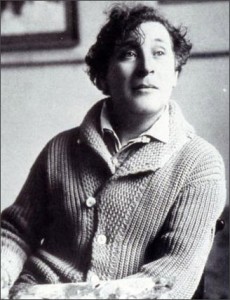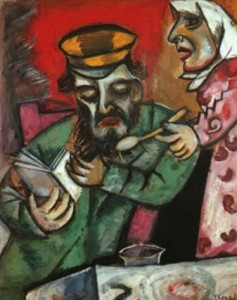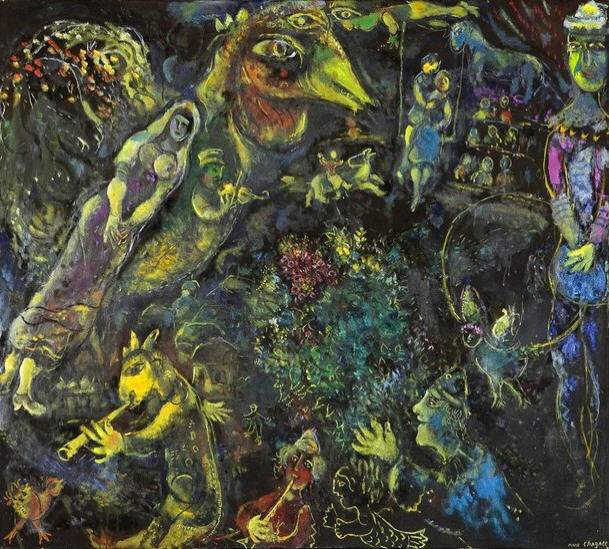| Marc Chagall | |
|---|---|
 |
|
| Born | Moishe Shagal July 7, 1887 Liozna, near Vitebsk, Russian Empire (present-day Belarus) |
| Died | Mar. 28, 1985 (at age 97) Saint-Paul-de-Vence, France |
| Nationality | Russian, later French |
| Movement | Surrealism, Expressionism |
| Field | Painting, stained glass |
| Marc Chagall Famous Paintings | |
| I and the Village, 1911 | |
| The Birthday, 1915 | |
| The Fiddler, 1913 | |
| La Mariée, 1950 | |
| Over the Town, 1918 | |
| White Crucifixion, 1938 |
Marc Chagall was born on July 7, 1887 in Belarus, Russia. His birth name was Moshe Shagal, but he changed it because as a painter Marc is much easier to remember. He was the eldest of nine siblings. Raised Jewish, religion would strongly influence him all his life. His dad was herring merchant, and although they were poor, the family was happy.
In 1906, Marc started studying painting under a local artist Yehuda Pen. The next year, he moved to St. Petersburg. He joined the Society of Art Supporters, and studied under Nikolai Roevich. Nikolai introduced Chagall to all the artists, like Van Gogh and Michelangelo. From 1908-1910, he took lessons from Léon Bakst at the Zrantsera School of Drawing and Painting.
This was a difficult period in Russia for the Jewish population; if you wanted to live in St. Petersburg, you needed a permit to, and the artists were frequently jailed for going against the Czar. Plus, Chagall was dirt poor, and he had hardly enough money for food let alone art. He moved back home at the end of 1910, and met his future wife, Bella Rosenfield.
One of his most famous paintings was finished the next year, I and the Village, 1911. It is considered to be a Surrealist piece, but it has the cubist angularity of a Picasso work. This painting focuses on the past, and his love for his village. The sheep and face are almost touching, with a flower below, as if they are in love. It has exceptionally expressive colors, to stress the emotions of this painting, which are love and happiness.
After gaining credit as an artist in his area, he moved to Paris. Marc exhibited his work at the Salon des Indépendents and Salon d’Automne in 1912. He had his first solo show in Berlin at the Herwarth Walden’s Der Strum Gallery. He moved back home in 1914, and married Bella the following year. They had their first child, a daughter Ida in 1916, and she is named after Marc’s mother.
His love for Bella was apparent in his art work. He painted many pictures of her, like Bella with a White Collar, 1917. It was just her, with a blue sky back ground, and a white collar on. The painting has Cezanne influence, with her being angular and the way the colors are smeared throughout the piece.
Chagall became an active participant in the Russian Revolution. The Soviet Minister of Art made him Commissar of Art, and he founded the Vitebsk Museum of Art and School near his home town.
Unfortunately, Chagall was considered a non-person because he was Jewish, so he and his family moved to Paris in 1922. One year later, he was asked by Ambrose Vollard to illustrate Dead Souls, a novel by Nikolay Gogul. In 1927, Vollard asked him again to illustrate a book, La Fontain’s Fables.
In 1931, Chagall took a trip to Jerusalem and Palestine. This inspired a painting series of Biblical stories. He became a French citizen in 1937. Shortly after, the Nazi’s occupied France, and Chagall and his family fled to Villa Air-Bel in Marseille, where American journalist Varian Fry assisted their escape through Spain and Portugal to America. Regrettably, Bella died on September 2, 1944, so when they settled in America, it was sad times. They hired a house keeper, Virginia Haggard McNeil to help out, and she ended up having an affair with Chagall. They had a son, David. When the war was over, they moved back to France and Virginia went with them; they lived in a villa in Provence, France. She left him though in 1952.
Marc remarried later on, to a woman named Valentine Brodsky, whom he called Vava for short. She was with him until the end. During the 60’s and 70’s, Chagall became immersed with stained glass. He did many windows; for example, the most famous are the two windows he did for a Cathedral located in Metz, France, and the 12 windows he did for a medical center in Jerusalem. These windows were completed from 1960-1962. All of them were biblical.
Chagall died on March 28, 1985 at the age of 97 in St. Paul, France. Before he died though, there was a large retrospective of his work, which is unusual because that usually happens after the person dies. Even though Chagall was considered a Surrealist/Fantasy artist, he didn’t believe in placing himself in categories. Marc thought that your artwork reflects who you are, and your life experiences. In an interview, he made it clear when he said, “The aroma of your birthplace clings to you.” His birth place is definitely present in I and the Village and other important works. Chagall is an artist that is very prominent to Surrealism, whether he wants to be or not. His art has influenced many people over the years, and will continue to in the future.


